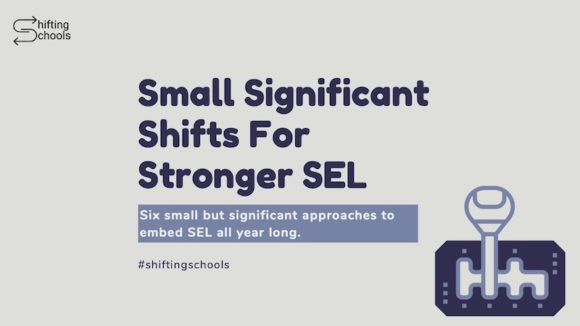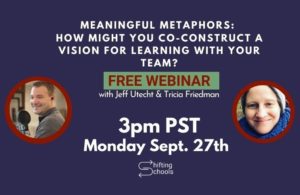
Your Classroom Mission Statement
This week we explore an idea that has meant a lot to me, not only as an educator and a business owner, but as a local resident of Seattle. The resource that pairs with this post is a free editable slide deck series that walks you and your students through the process of drafting a class mission statement. Inside the free PDF “Small Significant Shifts for SEL” the slide deck, you’ll find a few sample mentor texts of mission statements. We’ve linked the mission statements of Nike, Patagonia, The University of Washington, and the Seattle Seahawks. That’s right, the Seattle Seahawks have a mission statement:
Seahawks organization is guided by overall principles of acceptance and understanding that help us create a culture of respect, equality and inclusiveness both on and off the field. It is our goal to use these core principles and our commitment to passion, character and excellence to empower change within our community. We, as an organization and as individuals, represent and respect a wide range of human differences, personal experiences and cultural backgrounds.
Pretty powerful stuff, right? It is short and sweet, but also moving and clearly they get it–football is more than a game.
So let’s have a short little thought experiment with that mission statement. I want you to think of ONE, just ONE student from your past year, and try to see the following experiment through their perspective. I’m going to take that mission statement and turn it into a fill in the blank activity, and ask YOU to fill in the blanks answering from the lens of the student you selected.Â
Ready? Here we go:
- It is the goal of our classroom to commit to the following three things:
A)Â Â B) Â C) - We as a classroom will respect the following three things
A)Â B)Â Â C)
How hard or how easy did the answers come to you? Was it challenging to answer from the lens of a student?Â
You might already be excited about the idea of your students taking a mission statement mentor text and making it their own. I know I’ve really enjoyed that activity with learners. And if you have participated in any of the workshops with Shifting Schools, you’ve already heard me preach the benefits of scaffolding an activity like this. This is why inside the free slide deck, you’ll also find a few ways to do some pre-thinking. For me, my favorite pre-thinking activity is to ask students to think about the THREE verbs that really tell the story of what our learning community is like. To get to those three verbs, our resource recommends giving space and time for student to think about these three questions:
1) Last week, which word best described our learning:
a) navigating b) collecting c) exploring d) other
2) When you feel most connected to your classmates, which action are you engaging with:
a) demonstrating b) playing c) pioneering d) other
3) Pick one: Success in our class asks us to regularly…
- A) actÂ
- B) reflectÂ
- C) practiceÂ
- D) inquire
Now while this activity is great for students, the process of them collaboratively working towards a collective mission statement is a great way to bolster student ownership and foster community, but secretly there is another huge benefit to doing this activity: as a teacher it really helps you notice and get curious about how students are experiencing learning in your classroom.
In her book, Teaching to Transgress, Bell Hooks writes:
“As a classroom community, our capacity to generate excitement is deeply affected by our interest in one another, in hearing one another’s voices, in recognizing one another’s presence.â€
An activity like this one invites students to see how one another are experiencing learning, and to envision what they want it to be. Social Emotional Learning needs us to make space for conversations like this one. This is a wonderful way to have students not only get curious about each other’s experience, but also about their own. We know that self-awareness is a huge part of developing our social skills. In looking for ways to build it into our practice we rehearse it. So what I see is not just an opportunity in the rough-draft process of developing a mission statement just for my class–but I see an ongoing opportunity for each student to return to it later on. At the end of the day or end of the week I might create an exit ticket that invites the students to tell me how connected they felt to our mission statement at that point in time.Â
As an example of what that might look like, let me read you another mission statement, this one belongs to the toy you never want to step on: Lego
Their mission statement reads:
‘We want to Inspire and develop the builders of tomorrow’ Our ultimate purpose is to inspire and develop children to think creatively, reason systematically and release their potential to shape their own future – experiencing the endless human possibility.â€
So let’s say that was the mission statement my students came up with. My exit ticket might be as simple as this: On a scale of 1-5 how inspired were you this week? What could we do more or less of to help you feel more inspired? What might help you better understand what is inspiring your peers this week?
Now here is the crucial thing, if I am collecting exit tickets that tap into SEL, in order for my students to know I value it, I have to show I’m thinking about what they share. So every once in a while, I’ll speak to what their exit tickets are telling me, and I’ll let them know what changes I’m trying to make. It’s a two way street. If we go through the hard work of making our own mission statement, that mission statement needs to work for us, and we need to work at it.Â
Inside the free guide “Small Significant Shifts for SEL†you’ll find the slide deck that you can customize for your learners. The mission statement mentor texts in the example are local and personal for me, a Washington State resident. While they will work for you anywhere, it could be great to pick mentor texts that work for your location, and amplify small businesses in the neighborhood. You might even invite a small business owner to speak to your students about their process of drafting their mission statement.
By going to local businesses, you can ask students to have a conversation about how tangible their values are as a customer. For example, I live not too far from Pike Place Market, and they say that they are:
“… guided by the following values: collaboration, inclusion, respect, optimism and gratitude.â€
The next time I head to the Market, I’m going to be on the lookout–where do I see collaboration in motion? Where’s the respect? How inclusive is the market? Does it make me feel optimistic, and does it make me want to express gratitude?
Before you take your students through this experience maybe you too need a mission statement. What if you had a mission statement and you shared it with your students? What if you were in it together? Trying each day to live up to your own mission statement as you support students in doing the same.Â
{“type”:”block”,”srcClientIds”:[“879c712c-42b3-4acb-bccf-c0082bc10674″],”srcRootClientId”:””}I love hearing and reading other educators’ mission statements. Here’s Steve Murphy’s mission statement, a HS Social Studies Teacher:
Mission:Â Developing globally aware, empathic citizens with a passion for service learning and service leadership to positively impact the world around them.
Of course you can watch Steve’s free webinars in our webinar section under Resources on our website and see if he’s living up to his mission statement.
Or what about Tyler Rablin’s mission statement. Tyler is a HS ELA teacher, creator of our Making Assessment Meaningful Course and has two free Webinars as well for you to watch. His mission statement reads: Â
Mission: Creating passionate, well-rounded people who are excited about learning and empowered to make a difference in their own lives, their communities, and the world.
Mission statements aren’t just for companies or classrooms….we all have a mission statement just very few of us put it down for the world and others to see. Maybe it’s time to share your mission statement about what it means to be an educator with your students.Â
My mission statement you ask:
Mission: To support schools and organizations in preparing students for their future not our past.
Something you may notice is how each activity is somehow connected to the practice of noticing and wondering. Christina Cipriano, the director of research at the Yale Center for Emotional Intelligence said this about the essence of SEL:
“At the end of the day, we’re talking about teaching people how to be better citizens and more positive contributors to their society.†(courtesy of edsurge.com)Â
In my experience, if we want students to want to make positive contributions to their community, we need to get them curious about that environment, and we need to create opportunities for them to see it and think about it differently. That’s what this week’s resource is all about: asking questions about our purposes for being together, learning together, and wondering how we can best leverage our shared experience as learners.Â
If this resource inspires you to rethink your mission statement as an educator, or if you already have one, we’d love to hear about in the comments below.







